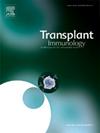The KIR/HLA class I co-expression and transplantation outcomes after HSCT/BMT from HLA-matched sibling donors
IF 1.4
4区 医学
Q4 IMMUNOLOGY
引用次数: 0
Abstract
Background
Natural killer (NK) cells express killer immunoglobulin-like receptors (KIRs), which regulate their functions. Self-human leukocyte antigens (HLA) class I molecules act as inhibitory molecules for KIRs, blocking the killing activity of NK cells. Since normal NK activity may affect the outcomes of hematopoietic stem cell transplantation (HSCT) or bone marrow transplantation (BMT) from their HLA-matched sibling donors, we investigated the interaction between KIRs and class I HLA presented on NK cells. Complications such as graft-versus-host disease (GvHD) or transplant rejection may result because of deficient expression of class I HLA ligand inhibitors in the transplant recipient.
Methods
We examined the effect of missing KIR ligands (MSL) and KIR haplotypes on GvHD development, relapses, death, infections, and cell recovery in HSCT patients. Our group included 59 patients [n = 24 with acute myeloid leukemia (AML), n = 12 with chronic myeloid leukemia (CML), n = 12 with myelodysplastic syndrome (MDS), and n = 11 with acute lymphoblastic leukemia (ALL)], who received HSCT/BMT from their sibling donors.
Results
Our results showed that haplotype AA was more common than Bx in donors for patients with MDS and was associated with a higher incidence of chronic (c) GvHD (p = 0.003). In this group, we also observed a statistically significant relationship between the AA donor haplotype and absolute neutrophil count reconstruction of 0.5 G/l (0.5 × 109 cells/L) under 28 days (p = 0.03). Our results also showed an excellent correlation between KIR MSL values and cGvHD in AML patients (r = 0.9932).
Conclusion
Our results indicate that KIR/HLA class I analysis at the stage of selection of a related donor could have an impact on the results of hematological transplantation and possibly reduce complications.
来自HLA匹配的同胞供者的HSCT/BMT后KIR/HLA I类共表达和移植结果
背景:自然杀伤细胞(NK)表达杀伤免疫球蛋白样受体(KIRs),该受体调节NK细胞的功能。自体人白细胞抗原(HLA) I类分子作为kir的抑制分子,阻断NK细胞的杀伤活性。由于正常NK活性可能会影响来自HLA匹配的同胞供体的造血干细胞移植(HSCT)或骨髓移植(BMT)的结果,我们研究了NK细胞上呈现的kir和I类HLA之间的相互作用。移植受体体内I类HLA配体抑制剂表达不足可能导致移植物抗宿主病(GvHD)或移植排斥等并发症。方法:我们研究了缺失KIR配体(MSL)和KIR单倍型对HSCT患者GvHD发展、复发、死亡、感染和细胞恢复的影响。本组纳入59例患者[n = 24例急性髓性白血病(AML), n = 12例慢性髓性白血病(CML), n = 12例骨髓增生异常综合征(MDS), n = 11例急性淋巴细胞白血病(ALL)],他们接受了来自兄弟姐妹供体的HSCT/BMT。结果:我们的研究结果显示,单倍型AA在MDS患者的供体中比Bx更常见,并且与慢性(c) GvHD的发生率较高相关(p = 0.003)。在该组中,我们还观察到AA供体单倍型与28 天内0.5 G/l(0.5 × 109个细胞/l)绝对中性粒细胞计数重建之间存在统计学意义(p = 0.03)。我们的结果还显示AML患者的KIR MSL值与cGvHD有很好的相关性(r = 0.9932)。结论:在选择相关供体阶段进行KIR/HLA I类分析对血液学移植的结果有影响,并可能减少并发症。
本文章由计算机程序翻译,如有差异,请以英文原文为准。
求助全文
约1分钟内获得全文
求助全文
来源期刊

Transplant immunology
医学-免疫学
CiteScore
2.10
自引率
13.30%
发文量
198
审稿时长
48 days
期刊介绍:
Transplant Immunology will publish up-to-date information on all aspects of the broad field it encompasses. The journal will be directed at (basic) scientists, tissue typers, transplant physicians and surgeons, and research and data on all immunological aspects of organ-, tissue- and (haematopoietic) stem cell transplantation are of potential interest to the readers of Transplant Immunology. Original papers, Review articles and Hypotheses will be considered for publication and submitted manuscripts will be rapidly peer-reviewed and published. They will be judged on the basis of scientific merit, originality, timeliness and quality.
 求助内容:
求助内容: 应助结果提醒方式:
应助结果提醒方式:


